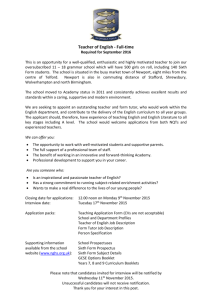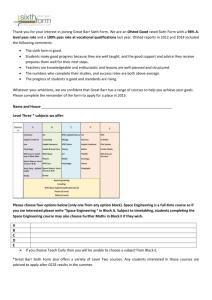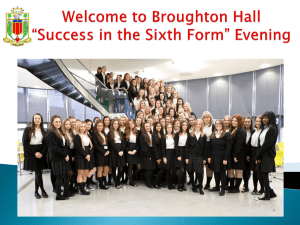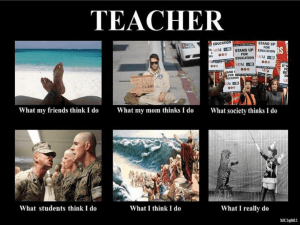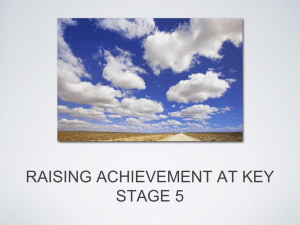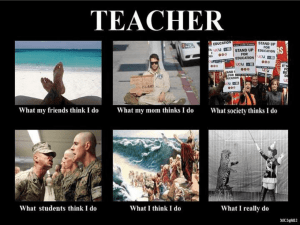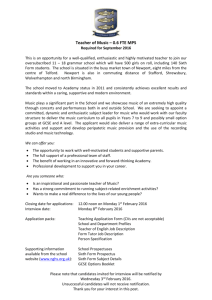FCPS Proposal
advertisement
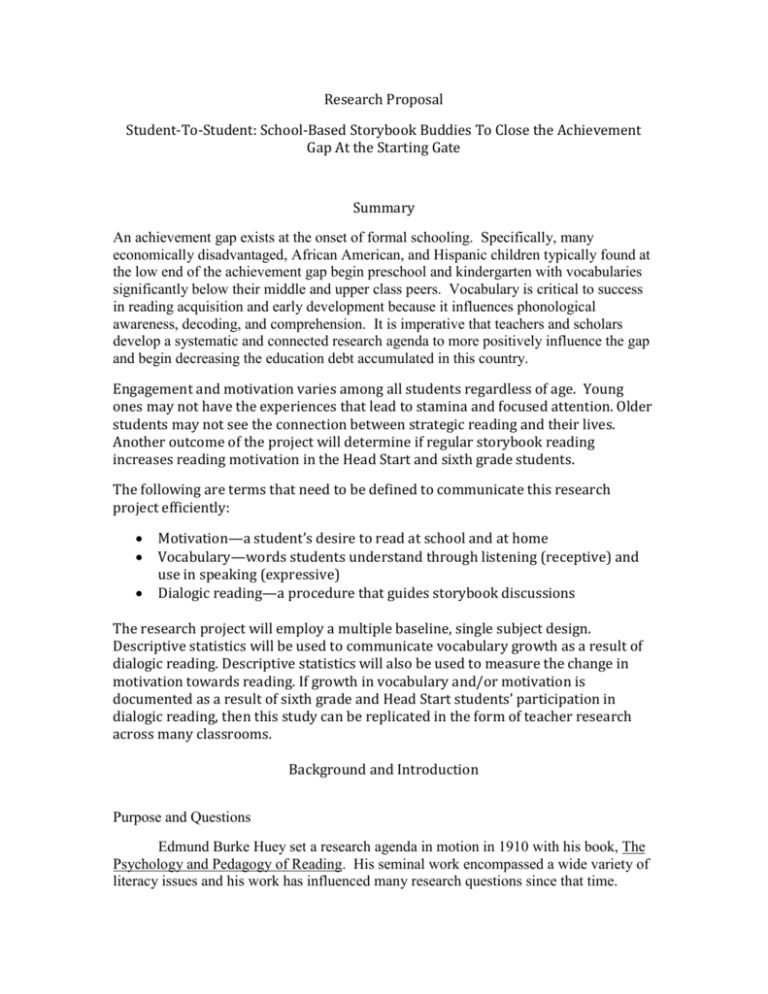
Research Proposal Student-To-Student: School-Based Storybook Buddies To Close the Achievement Gap At the Starting Gate Summary An achievement gap exists at the onset of formal schooling. Specifically, many economically disadvantaged, African American, and Hispanic children typically found at the low end of the achievement gap begin preschool and kindergarten with vocabularies significantly below their middle and upper class peers. Vocabulary is critical to success in reading acquisition and early development because it influences phonological awareness, decoding, and comprehension. It is imperative that teachers and scholars develop a systematic and connected research agenda to more positively influence the gap and begin decreasing the education debt accumulated in this country. Engagement and motivation varies among all students regardless of age. Young ones may not have the experiences that lead to stamina and focused attention. Older students may not see the connection between strategic reading and their lives. Another outcome of the project will determine if regular storybook reading increases reading motivation in the Head Start and sixth grade students. The following are terms that need to be defined to communicate this research project efficiently: Motivation—a student’s desire to read at school and at home Vocabulary—words students understand through listening (receptive) and use in speaking (expressive) Dialogic reading—a procedure that guides storybook discussions The research project will employ a multiple baseline, single subject design. Descriptive statistics will be used to communicate vocabulary growth as a result of dialogic reading. Descriptive statistics will also be used to measure the change in motivation towards reading. If growth in vocabulary and/or motivation is documented as a result of sixth grade and Head Start students’ participation in dialogic reading, then this study can be replicated in the form of teacher research across many classrooms. Background and Introduction Purpose and Questions Edmund Burke Huey set a research agenda in motion in 1910 with his book, The Psychology and Pedagogy of Reading. His seminal work encompassed a wide variety of literacy issues and his work has influenced many research questions since that time. Huey speaks at length about how visual perception works in tandem with previous experiences and language. He noted how beneficial the home life was in early literacy because of its ability to capitalize on language and experience. He went so far as to say that schools should replicate these characteristics in “schools of the future.” Huey’s work and the work of others since that time leads to the following research questions: Two what degree is vocabulary increased through routine dialogic reading in first language between sixth grade students and Head Start students? How is student motivation influenced by participation in regular dialogic reading experiences in the classroom? It is my intent to join the scholarship of teaching and learning by working with teachers and students in an effort to bring research into classroom practice, which will, in turn, inform future research. Theoretical Framework Critical realist lens and schema theory are tapped in this study. A critical realist stance recognizes that empirical knowledge does exist, but it is always influenced by the social constructions within any given context. Schema theory captures the essence of zone of proximal development and zone of possibilities as they pertain to vocabulary learning and professional learning respectively. Schema influences a child’s zone of proximal development by providing the background for that child’s socially constructed learning about words and their ability to describe our world. Schema also influences collaborating adults’ zone of possibilities by providing the background for socially constructed understanding of existing knowledge in application while simultaneously generating new knowledge grown from this contextual application. The new scholarship in teaching and learning captures the critical realist stance and offers a place to launch. The two combine to form a potentially powerful mechanism in closing the achievement gap. Practitioners that embrace teacher research and scholars that embrace action research can join to form a feedback loop circulating through universities and P-12 schools and informing policy, practice, teacher education, and future research. Communities of practice consisting of researchers and teacher researchers can serve this purpose as we strive to learn more about how to close the achievement gap at the starting gate. Related Literature The literature review will draw extensively from the field of emergent literacy. Emergent literacy will be broken into two areas: language development and phonological and phonemic awareness. Emergent literacy attempts to “operationalize” many of the pedagogical implications outlined by Huey. My emerging research agenda seeks to highlight the systems oriented relationship between language (vocabulary and syntax), background knowledge, and reading acquisition and early development. Huey, Toraq and others speak to the relationship between background experiences and how what is visually perceived is processed in the act of reading. Specific to my dissertation, emergent literacy seeks to connect language development and vocabulary to future literacy learning. Lonigan and others have linked vocabulary to phonological awareness. Thus, vocabulary and language is not only important to comprehension typically considered after the reading acquisition stage, but is also significant in the development of phonological and phonemic awareness and to decoding. The relationships between vocabulary and reading are critical as we seek ways to address the achievement gap during the preschool and kindergarten years. Research Design and Methodology The action research methodology encompasses the idea that those closest to the problems being researched offer the most applicable solutions, which is in the spirit of the new scholarship of teaching and learning. Single subject research allows for the systematic observation of an intervention’s impact on a specific outcome within specific contexts. This project will employ a single subject, multiple-baseline-across-subjects research design. The intervention will involve pairing each Head Start student with a sixth grade student as his/her reading buddy. These pairs will remain the same throughout the 9-week project. Students will read and discuss storybooks for 15 minutes each day. All pairs participate in a pre and post treatment measure of motivation using the Elementary Reading Attitude Survey. The measure has been adapted for the Head Start students. Three pairs will participate in dialogic reading using the multiple-baseline-across subjects design. Sixth grade students will prompt younger students to explain targeted word meanings. Sixth grade students will document younger students' accurate responses using the word "yes" and inaccurate responses with a "no." Research Instruments The following measurements are attached: Elementary Reading Attitude Survey Elementary Reading Attitude Survey Adapted Vocabulary Protocol for A Pocket For Corduroy Sampling All 17 Head Start students at the site will be invited to participate. 18 sixth grade students will be recruited through a classroom talk. The researcher will arrange to meet with parents of the sixth grade and Head Start students to explain the letter for informed consent. Interpreters will be present. Each parent will receive a copy of the signed consent form after it is signed and photocopied. Active assent will be read to each student and his or her response will be documented on the attached assent form. Data Collection Sixth grade students will collect data on vocabulary acquisition after each dialogic reading session. The vocabulary protocol is attached. The sixth grade student will prompt the younger buddy to select a picture of a particular vocabulary word out of eight possible choices. The older student will put the picture into an appropriately marked envelope (correct, correct with verbal explanation, and incorrect). Each will last about five minutes. Sixth grade students will also collect data on the younger students’ motivation using an adapted Elementary Reading Attitude Survey. This adaptation is attached. This data will be collected as a pre and post measure of the intervention. Each session will last five minutes. Sixth grade students will complete the Elementary Reading Survey as a pre and post, paper pencil assessment. The survey is attached. The data collection sessions will last 15 minutes. Data Analysis Descriptive statistics will be used to analyze vocabulary growth and changes in motivation. Reporting the Results The results will be reported to two different audiences. First the researcher and teacher will submit a proposal to present at the Fairfax County Public Schools Teacher Research Conference. Second, the supervising academic scholar, Dr. Susan Burns, and the researcher will submit the results in the form of an academic paper to an appropriate journal. Time Lines November: HSRB and FCPS Approval December 2008: Recruit students Gather consent via a one-hour parent meeting with an interpreter Gather assent forms via brief conversations between researcher and students Provide time for buddies to establish rapport Train sixth grade students in dialogic reading during three 15-minute sessions Train sixth grade students in data collection during one 15-minute session January 6, 2009: Sixth grade students complete the Reading Attitude survey during a 15-minute session. January 7, 2009: Sixth grade students gather data on the adapted Reading Attitude Survey for the Head Start students during one of the buddy reading sessions. January 8, 2009: Continue building report through buddy reading January 12, 2009: Meet with sixth grade students to review the dialogic reading and data collection procedures. January 13-January 15, 2009: Collect baseline data for storybook one. January 19- January 22, 2009: Engage in dialogic reading with storybook one, collecting data at the end of each session. January 26-January 29, 2009: Collect baseline data for storybook two. February 2-February 5, 2009: Engage in dialogic reading with storybook two, collecting data at the end of each session. February 9-February 12, 2009: Collect baseline data for storybook three. February 16-February 19, 2009: Engage in dialogic reading with storybook three, collecting data at the end of each session. February 23-February 24, 2009: Wrap up dialogic reading data collection February 25, 2009: Sixth grade students gather data on the adapted Reading Attitude Survey for the Head Start students during a 15 minute buddy reading session. February 26, 2009: Sixth grade student complete Elementary Reading Attitude Survey during one of the buddy reading sessions. Source of Funding There is no funding necessary for this project. Part IV Required Enclosures A. The Human Subjects Review Board is holding approval until permission from FCPS is granted. A copy of the HSRB application is attached and is signed by the supervising researcher/professor, Dr. Burns. B. Three copies of each of the following instruments are attached: 1. Elementary Reading Attitude Survey 2. Protocol for the adapted Elementary Reading Attitude Survey 3. An example vocabulary data collection protocol for dialogic reading C. No copyrights are attached. D. Current vita for Mary Jane McIlwain is attached.
